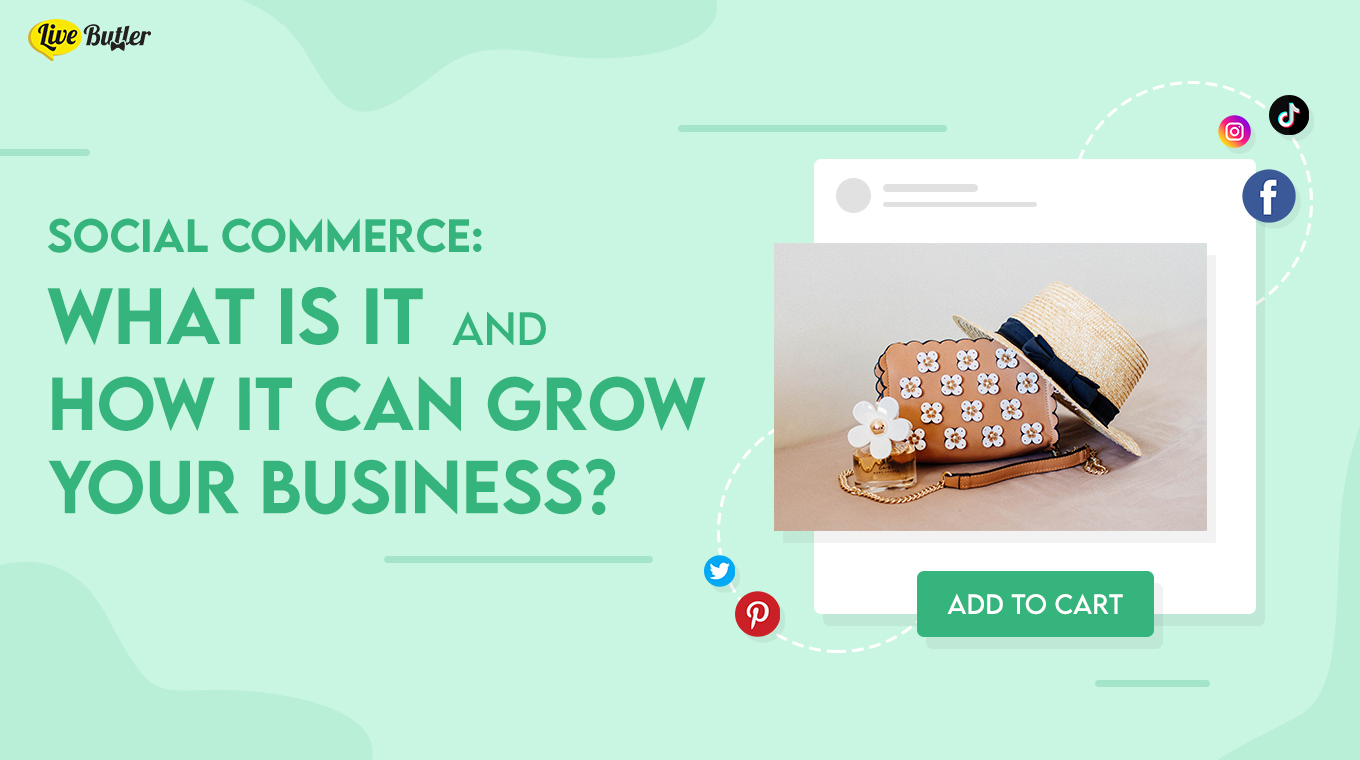
20 maj Social Commerce: What is it and How it can grow your Business?
Imagine you’re scrolling through Facebook, catching up on friends’ activities and the day’s news. Somewhere in the middle, you come across a sponsored post by an apparel brand, featuring a model wearing a sweater that you know would be a perfect staple in your fall wardrobe.
Luckily, the image contains a “View Products” tag, which takes you to a product page with pricing and details about the sweater. You select your size, tap “Buy Now” and, in just a few clicks, complete your purchase in the app. And without missing a beat, you go straight back to scrolling through your feed.
You may or may not know it, but you just experienced social commerce in action.
Social commerce is the product of combining the best of e-commerce with social media. It’s set to revolutionize the way we shop: affording new opportunities for people to participate in the global economy as consumers, creators, influencers, and sellers, resulting in a power shift from big to small.
Almost half of the brands have already invested in social commerce because of how promising it is. Last 2020, the global market for Social Commerce was estimated to be at US$89.4 Billion and is projected to reach a revised size of US$604.5 Billion by 2027.
If you’re a business that sells products, this info probably excites you. That is why in this article, we will you a detailed breakdown of social commerce: what it is, how it works, and most importantly, how you can strategically take advantage of this new revenue opportunity.
What Is Social Commerce?
Social commerce is the process of buying and selling products or services directly within a social media platform. It uses networking websites such as Facebook, Instagram, and Twitter as vehicles to promote and sell products and services.
It’s different from a traditional social media marketing strategy, where users view a brand’s content and visit their website to start shopping. With social commerce, social commerce gives customers the option to checkout directly from social platforms. Or, in some cases, the social platform may contain links that lead directly to the checkout page where the customer can also complete their purchase.
In 2020, Facebook, Instagram, and Pinterest launched revamped social commerce tools to help retailers streamline online shopping experiences in the midst of the pandemic. These features create new digital storefronts that can be found organically or boosted through paid advertising.
Executives overwhelmingly agree that social commerce is driving an increasing portion of their company’s marketing-driven revenue, according to The State of Social Media Investment Report. About eight in 10 expect to be selling their products or services via social within the next three years.
Why is social commerce worth the investment?
Social commerce offers something radically different from traditional e-commerce by weaving buying and selling into the fabric of everyday life and through a real sense of community and connection. It’s set to revolutionize the way we shop.
People want to buy products and services based on recommendations and inspiration from people they trust. That could be family, friends, and communities, and it can also be authentic influencers they follow on social media. They want to feel inspired, informed, and confident in what they buy. Social commerce serves these needs, providing an enhanced shopping experience that sparks discovery, enables personalization, and leverages individuals’ expertise and authenticity to build trust. All of this is already playing out in China, where social commerce on platforms like Taobao Live, generated more than $400 billion in sales in 2021 alone.
Around 3.5 billion people4– 44%+ of the world’s population – use social media, with consumers in developing countries more likely to have a smartphone with social media apps than they are a laptop. On average consumers spend two and a half hours a day on social platforms5, with more than 300 million new social media users coming online between 2019 and 20206. For many people, social platforms are the entry point for everything they do online – news, entertainment, and communication. Now commerce is in the mix too. And it could soon become so powerful as a destination in its own right that it starts to threaten the dominance of e-commerce and search giants.
Benefits of Social Commerce
In case you aren’t yet convinced that social commerce is necessary for your business, here are a few key benefits that might sway you.
There are huge numbers of potential customers on social media
According to Statista, there were over 3.6 billion social media users globally in 2020, and this number is expected to reach 4.4 billion by 2025. With more of these users starting to shop through social media, this is a huge opportunity for you to get your products in front of new faces and grow your audience exponentially.
Considering the high level of impulse buying, particularly among millennials and gen Xers, social shopping holds huge potential for attracting customers and increasing sales.
48% of U.S. internet users of this age made a purchase on social media in 2019. For those in that demographic who haven’t shopped on social media yet, 27% have expressed interest in giving it a go.
The key is to leverage this purchase behavior by making it as seamless as possible for customers to checkout directly through their social media platforms, with little to no disruption.
You can reach your target audience
Social commerce is all about meeting your customers where they are. And likely, most of your customers are already on social media. This gives you the perfect opportunity to engage with existing customers in a new, more authentic way by sharing your brand voice through creative content.
Many social media platforms also come with analytics capabilities that allow you to track users’ social and buying behaviors over time. Using this information, you can cater your content and products directly to your target audience.
Of course, to reach your target audience, you first have to know your target audience. For example, if most of your customers are in the age range of 30 and up, TikTok might not be the best option for your business.
So, take time to gather demographic data about your customers, identity what they like and don’t like, and perhaps even talk directly to them to get more insight into how you can best serve them. Then, reach your audience with products and messaging that best meets their needs.
You can Convert customers exactly where they are
See it, click it, buy it. Social media shops remove friction from the consumer journey, making it easy to follow through from discovery to purchase.
Ultimately, every click of the mouse is an opportunity for potential customer to change their mind. If they have to go from your ad to your website, add the product to a cart, to fill in their credit card info, that’s a lot of moments to lose their attention.
Take those unnecessary steps away and just bring the shopping right to social. Removing a step in your buying process can reduce friction in your sales funnel, capturing revenue that might have been lost if a buyer did not follow through on a redirect.
You can establish social proof
If your business is new to selling online, many of your audience may not trust your brand right away. Many may not be fully convinced until they read customer reviews, compare products or talk to other customers who can vouch for your product or service. Luckily, with social commerce, your social media accounts are the perfect place to begin establishing much-needed social proof.
Through user-generated content such as comments, likes, follows and shares, brands can create a positive feedback loop that keeps customers coming back for more. The more users who interact with and promote your products, the more likely that other customers will trust your brand, too.
Some tangible ways to generate social proof are providing customers with incentives to share your content, such as coupon codes, discounts, or a giveaway. Or, create a fun hashtag that customers can use to share pictures and videos of products and engage with your brand’s community.
Enhanced social media presence and brand awareness
Instead of keeping your social media and eCommerce site siloed, social commerce gives merchants the power to merge the two. This is a huge branding opportunity, allowing you to create brand awareness and stay top-of-mind with your customers through daily content.
One key way to build brand awareness is through influencer marketing.
Of course, it’s every eCommerce brand’s dream to have a professional athlete, actress or celebrity endorse their products. Unfortunately, this isn’t an accessible option for many smaller brands on a tight budget.
Luckily, influencer marketing has taken on a new meaning in recent years, as customers aren’t necessarily looking to big-name celebrities for advice — rather, they’re seeking authenticity, largely from micro-influencers whose lifestyles are similar to their own.
In fact, a 2021 survey of US social media users showed that, for 53% of respondents, posts by influencers played the biggest role in their purchasing decisions. This goes to show that customers yearn for brands that others trust, so if you’re looking for ways to increase brand awareness, influencer marketing may be an investment worth making.
Social commerce best practices
Ready to take advantage of these social shopping trends? Here are five best practices to start your social commerce strategy off on the right foot.
Choose the right platform
Although there’s a good chance that your target customers are active across different social media platforms, it is not good for your business to be everywhere at once. You might be wasting your limited marketing resources on marketing on every platform.
So, dive into the data you already have from existing customers—the types of people already proven to have an interest in your products. Check what platform they are most active on? Which sales channel drives the most revenue for your business? Which has the higher conversion rate? Then prioritize platforms that come up top.
Find the right format
Once you’ve chosen the social media platform you will use for your social commerce, discover which formats work best to reach and convert them.
Say your target customers are makeup shoppers. In that case, live sale your product on Facebook Live. Invite beauty influencers to join—either as the model or the person applying the product.
Whatever the format, consider the time of day, how long you’ll be live, and which channel will best reach your audience. You don’t want to take up too much of your audience’s time, nor go live when they’re offline.
And remember: the back-and-forth conversation viewers have throughout live selling is a huge contributor to the sales they drive. Ensure to answer customers’ questions and engage with your customers.
Prioritize visuals
More than two million Snapchat videos, 240,000 Facebook photos, and 575,000 tweets appear every minute. Your branded content needs a reason to stand out. The visual appearance of your social media content plays a role in whether people will engage with it.
But it’s not just pretty photos and videos that matter. If you’re creating an online shopping experience, dress your social shop with as much care as you would your website storefront.
Automate your social commerce
Automating your social commerce can make a big difference in your customer’s shopping experience. With the right tools, you can automate your social commerce and make sure that your customers will have the best shopping experience.
If you are doing live selling or static post selling on Facebook, you can use a tool like Live Butler to automate the way you accept customers’ orders, update inventory, and send invoices.
Live Butler is a free complete e-commerce solution that simplifies the way businesses sell their products on social media. This includes automated invoicing. We will accept all the reservations made in the comment section and make the invoices through comment selling. We will instantly send the invoices to your customers through Messenger with the checkout link, where they can make their payment.
Engage with your followers
To create a great social commerce experience, you’ve got to remember the “social” part.
You can’t just toss up your catalog and forget it. Answer questions, and offer value and interesting content. Remember that your customers can’t physically see your products and the only way they can know more about your product before making their purchase decision is through engaging with you, the seller.
Encourage Customer's to give reviews
93% of online shoppers say a review can make or break their decision. If you’ve got a product people are happy with, get them to help spread the word.
Whether it’s an automated follow-up email asking for a review after a product has been delivered, or incentives like a contest to encourage previous customers to weigh in and share their experience, collecting social proof is vital to building a positive reputation online.
Once you’ve got some positive reviews, share them on your social feeds in creative ways, whether that’s posting user-generated content, hosting a Live video with happy customers, or simply creating a carousel of positive comments. There are tons of ways to do this that won’t make you sound like you’re bragging.
Final Thoughts
Social commerce is a model that brands, retailers, and platforms must embrace. For platforms, it opens up new revenue streams just as growth in digital advertising is expected to slow. For retailers, there are opportunities to develop new types of shopping experiences, connect in new ways and engage influencers/creators. And for brands it means embracing the shift from big to small, empowering small businesses, and engaging directly with consumers through social platforms.
This is not just accessible for larger, multinational brands, but it’s also accessible for all brands, both big and small, to experiment with social commerce and leverage it to grow their businesses.
Ultimately, many of the most successful businesses are the ones that weave together all business channels, online and offline, to create a consistent, engaging customer experience. And leveraging social commerce is a key way to achieve that.
With these tangible examples in your back pocket, you’ll be well on your way to implementing a successful social commerce strategy that meets your audience where they’re at and gives them an unforgettable customer experience.

 Your privacy is safe. We will never share your information.
Your privacy is safe. We will never share your information. 



 Danish
Danish English
English
No Comments